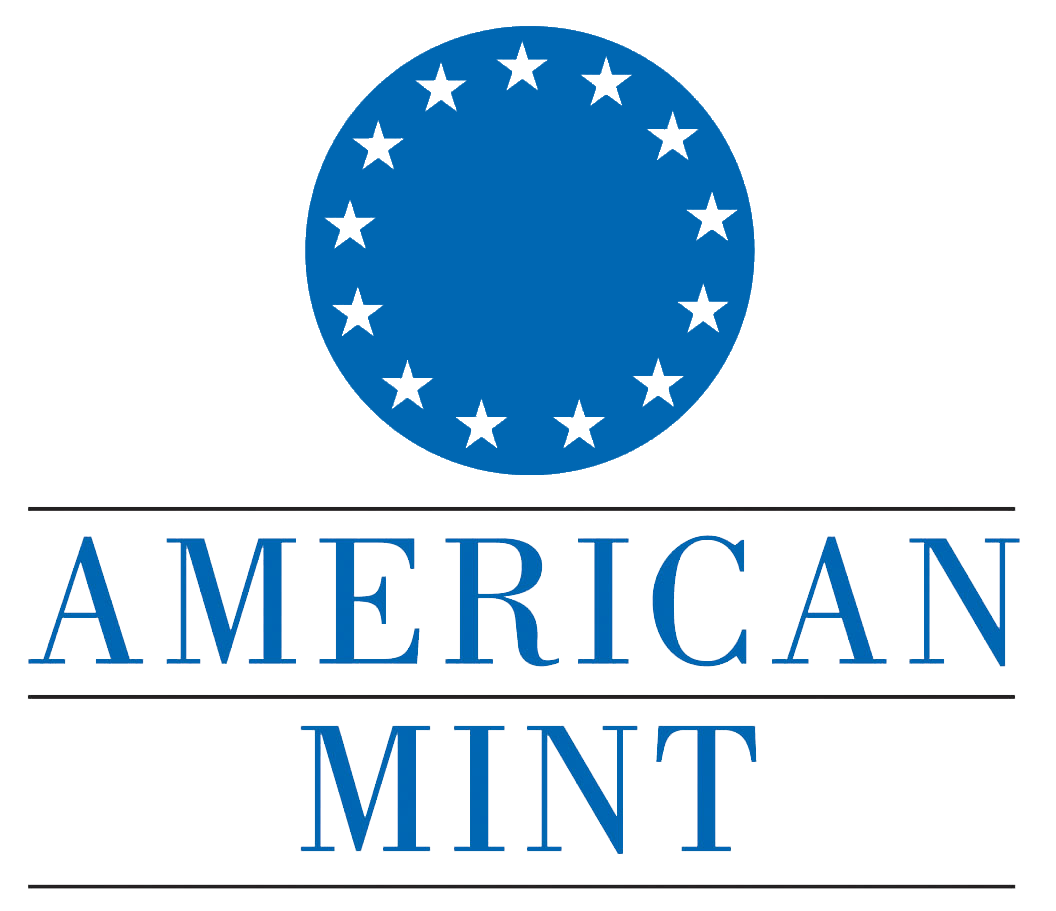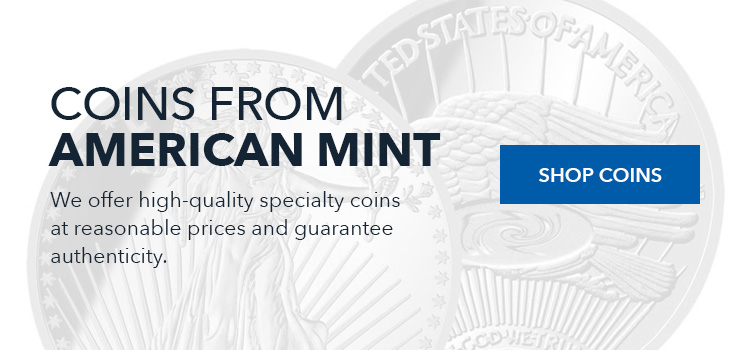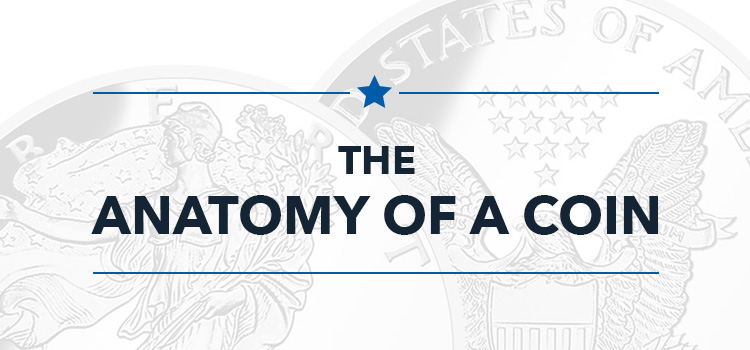
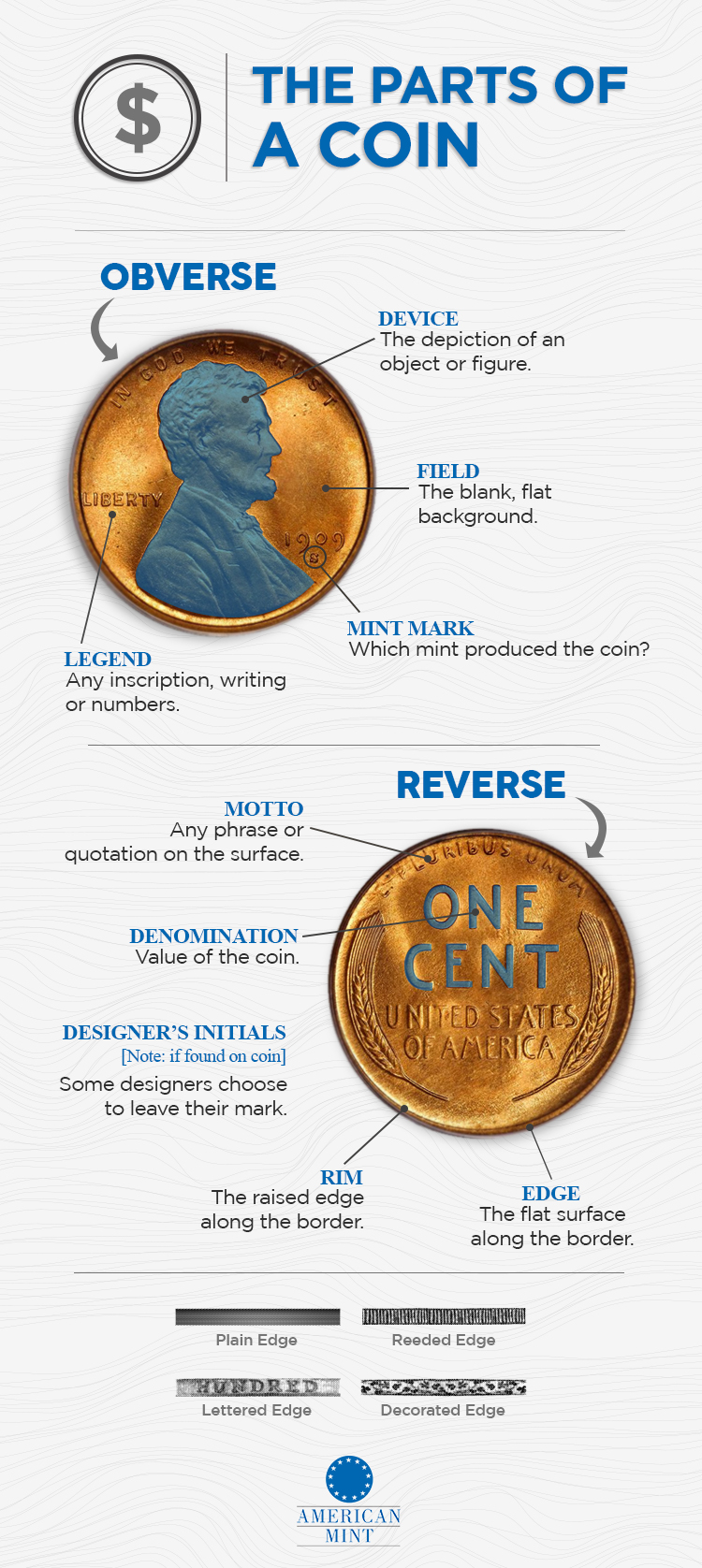
Have you ever wondered what the different parts of a coin are called, and how they all work together to create the complete coin? As a casual user of coins, this might not be a question that’s ever crossed your mind, and truthfully, there would be little reason to wonder. But as a curious numismatist, these are the types of questions that may begin to interest you.
Learning a little coin anatomy for beginners is a crucial step in becoming an experienced coin collector. These are the terms that dealers, salespeople, and other collectors will be throwing around, and if you don’t have a firm grasp of what they mean, you may quickly find yourself feeling confused and overwhelmed.
To help you learn the different parts of a coin, what they’re called and what they bring to the coin as a whole, we’ve created this guide on the anatomy of coins. As you browse through this coin term glossary, consider grabbing a few of your own coins to have handy, so you can compare the terms we discuss here to the coin in your hand. Then you can see for yourself what these terms look like in practice.
What Is a Coin?
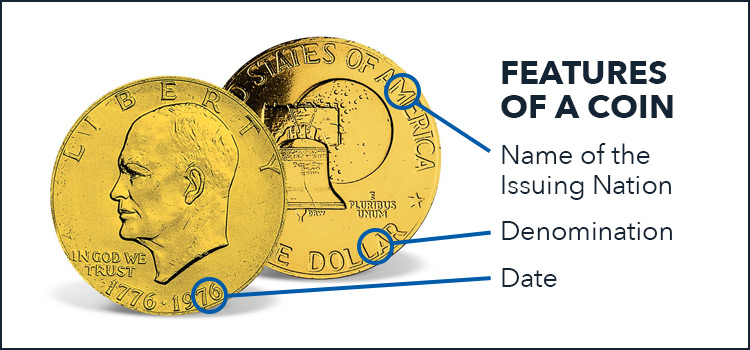
This might sound like a bit of a silly question, but it’s worth asking. Did you know that for a coin-shaped object to be considered an official coin, there are three distinct features it needs to display? These three features are:
- The Name of the Issuing Nation: If the coin was never officially issued by the government of any recognized nation, then it can’t truly be considered a coin. For example, game tokens, no matter how much they might look like coins, would not officially qualify for this label.
- The Denomination: This tells how much the coin is worth. Is it worth 50 cents? A dollar? Five dollars? Without this denomination, the coin is not truly a coin.
- The Date: This tells when the coin was minted, giving insight into what materials and precious metals are included in the coin’s composition, as these often change over time.
What Are the Parts of a Coin Called?
Let’s begin with a quick breakdown and glossary listing of all the main terms you’re likely to come across in coin anatomy, before breaking down each term in greater detail. Every coin, no matter how simple or elaborate, consists of these same elements:
- Date: This designates the year in which the coin was minted.
- Denomination: This tells how much the coin is worth, i.e., one cent, five dollars, etc.
- Designer’s Initials: Some designers may place their initials somewhere within the coin’s design.
- Device: This is a term for any objects or figures depicted on the coin’s surface. For example, Lady Liberty would be considered a device.
- Edge: The flat surface along the border of a coin. Sometimes referred to as the third side.
- Field: The field of a coin is the blank background or any part of the coin that remains flat and free from ornamentation.
- Incuse: Any part of a coin’s design that is imprinted below the surface of a coin.
- Legend: Any inscription, writing, or numbers present on a coin.
- Obverse: The front side of a coin, otherwise known as the “heads.”
- Mint Mark: This is a tiny distinguishing mark that signifies which mint produced the coin.
- Motto: Any phrase or quotation on the coin’s surface.
- Relief: Any part of a coin’s design that is raised above the surface.
- Reverse: The back side of a coin, otherwise known as the “tails.”
- Rim: This is the raised edge along the border of a coin that prevents the side from lying flush against a flat surface.
- Side: The large, flat round surfaces of a coin. Every coin has two sides.
The Bones of a Coin
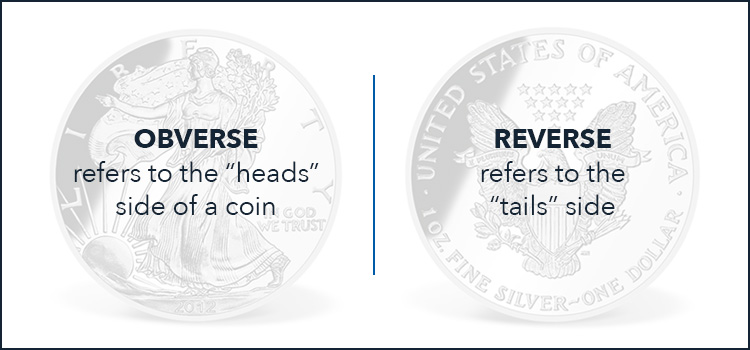
As we all know, a coin is a mostly flat disc with a design stamped onto it. By necessity, this means a coin will have two sides and a thin edge separating them. These two sides of any coin are colloquially referred to as the "heads" and the "tails." In American currency, the heads side typically features a portrait of a former president, statesperson, or leader. The tails, on the other hand, might feature an image of a well-known landmark or object with some symbolic meaning.
In professional numismatic terms, however, there are much more official terms for these sides than simple “heads” or “tails.” In professional circles, these sides are known as the obverse and the reverse. The term obverse refers to the “heads” side of a coin, or the side featuring the portrait, while the term reverse refers to the “tails” side.
What Is the Edge of a Coin Called?
A common point of confusion for new coin collectors who are not yet familiar with the terminology comes from terms like “edge” and “rim.” While it may seem that they could be used interchangeably, they are, in fact, different. Let’s look at each term separately.
What Is the Rim of a Coin?
If you place a coin flat on a table, you should see that there is a raised perimeter that forms the border of the coin. This raised border prevents the coin from truly lying flat against the table, thus keeping the design on the coin safe from any damage that might occur as a result of constantly rubbing against surfaces when laid flat against them.
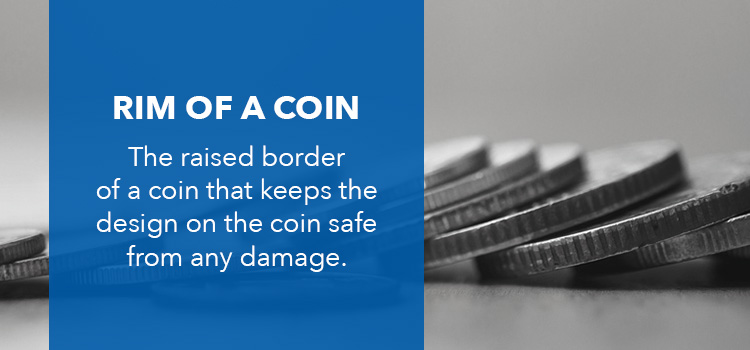
This raised border is what’s known as the rim. Essentially, the rim has two surfaces, one on either side of the coin. These surfaces can be viewed from either side, the obverse or the reverse, but it cannot be seen as well from the side.
While a coin’s rim is not typically a major site for complicated decorations or ornamentation, it may sometimes be dressed up slightly. It may be decorated with ridges or evenly spaced bumps. In many cases, however, it is left plain.
What Is the Edge of a Coin?
The edge is different from the rim. If you keep your coin flat on the table and look at it from the side, the surface you'll see is the edge. The edge is the narrow surface that runs lengthwise around the perimeter of the coin. If you hold a coin between your thumb and your forefinger so as not to touch the sides, the surface you are holding is the edge. Because this edge surface is often fairly wide, it is known in some cases as a coin’s third side.
Edges are often decorated. One common edge design features something known as reeding. A reeded edge has a series of tiny grooved lines all the way around it, and you can feel them as you run your finger along the edge. Sometimes, an edge might even feature writing, such as a motto or the coin’s denomination. This would be known as a lettered edge. It may also be engraved with a different design, in which case it would be called a decorated edge.
While these types of ornamental edges are fairly common, it’s also quite common to simply leave the edge blank. This leaves it as a smooth, flat surface.
The Design of a Coin
Now that we know a bit more about the large, structural elements of a coin, let’s take a closer look at the different decorative elements that make up a coin. This includes things like the writing, the images, and the identifying marks that help distinguish one coin from another and make them beautiful objects worth collecting.
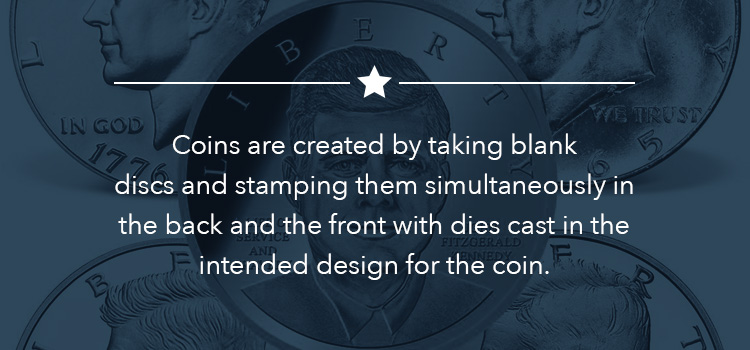
Coins are created by taking blank discs, known as planchets, and stamping them simultaneously on the front and back with dies cast in the intended design for the coin. These dies work together to stamp a pre-determined image into the metal, imprinting some of the design below the coin’s surface while also creating designs that are raised above the coin’s surface. On many coins, the design will include both of these elements, which is why it’s important to have names for both of them.
Any design element that is essentially pushed into the surface, creating an imprint in the metal itself, is called incuse. On the other hand, any design element that is raised above the surface of the coin is said to be a relief. These design elements work together to create all the images and writing we see on our coins.
Typically, the vast majority of a coin’s design is done in relief. This means if you were to close your eyes and run your fingers over the surface of a coin, you would be able to get a pretty good idea of what the image was even without looking.
What About the Images in a Coin’s Design?
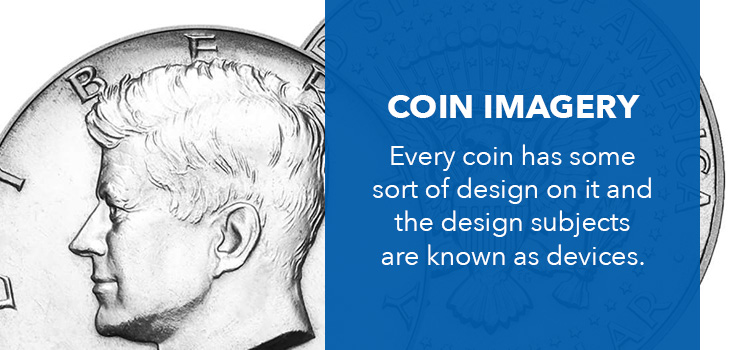
Every coin has some sort of design on it. In the United States, we’re used to seeing Lady Liberty, eagles, buffalo, past presidents and historical figures, national landmarks, and more. All of these types of design subjects are known as devices. For example, if you were to ask what the device on a penny is, the answer would be Abraham Lincoln on the obverse and the Lincoln Memorial on the reverse.
As United States coinage demonstrates, historical figures are common choices for devices. Other popular options include national symbols or landmarks that are important to a nation’s history. For example, the bald eagle is the national bird of the United States and is a popular symbol of freedom, making it a common choice on currency.
While the device on a coin is important, the field is equally so. The field refers to the background space of a coin. This is the part of the coin’s surface that is unmarked by design and that remains flat and blank. While this may seem insignificant, the very fact that it exists makes it possible for the device to exist as well.
What About the Lettering and Numbering on a Coin?
There are plenty of different places for numbering and lettering on a coin’s surface, and sometimes even along the edge. Let’s go over each of them separately.
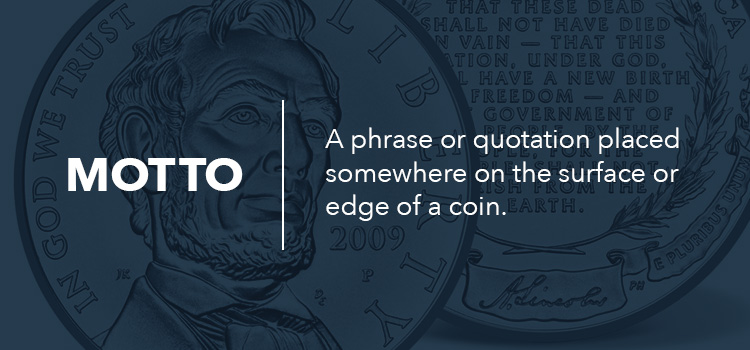
1. The Motto
On United States coinage, we’re used to seeing the phrase IN GOD WE TRUST. This is what’s called a motto, a phrase, or quotation placed somewhere on the surface or edge of a coin. Other mottos we might be familiar with include “E PLURIBUS UNUM." Like the major devices on a coin, mottos are typically chosen for their national significance. In most cases, the motto is the secondary inscription and is set in a smaller type than the primary inscription.
2. The Legend
The legend is the primary inscription on a coin. In many countries, it might be the name of the ruler, or it may even be the name of the country. It may also be an ideal, such as LIBERTY. It is also usually set in a larger or bolder type than the motto, making it more immediately noticeable.
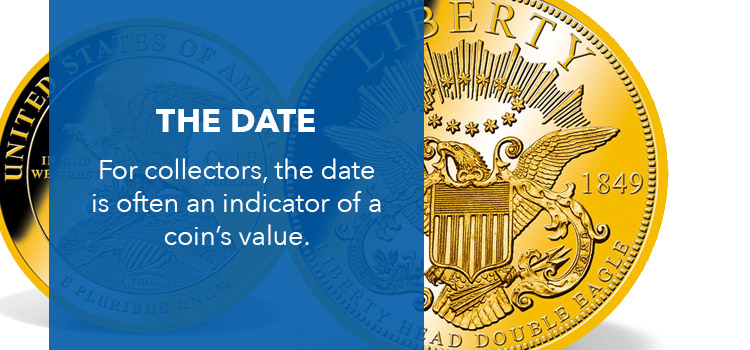
3. The Date
The date is an important element of a coin because, as we mentioned earlier, this is one of the features that every coin must have if it wants to qualify as a coin. With the exception of certain situations such as commemorative coins, it’s against the law to stamp coins with a date outside of the year in which they were actually minted. For example, unless there were special circumstances, a coin minted in 2018 could not be dated as 2016. Because the precise metal combination and design of coins changes frequently, this date stamp helps distinguish them.
For collectors, the date is also of particular significance. It is often an indicator of how valuable a coin is, and it helps them place specific coins within a series.
4. The Designer’s Initials
Not every coin out there has its designer’s initials on it. Sometimes, designers may not be able to sign their creations. For some coins, however, the designer’s initials are worked into the design, usually hidden fairly subtly in one of the devices. Depending on the particular coin and the history, this may even make a coin more valuable for collectors.
5. The Mint Mark
This is a mark, usually a letter or a pair of letters, that signifies which mint the coin originated from. This is because there are multiple mints around the country that are all minting official coinage. Without this signifying mint mark, it would be impossible to tell which mint a coin had originated from, should the need to learn this information arise.
The following mint marks you may encounter on U.S. coinage are as follows:
- P – Philadelphia, Pennsylvania (If there is no mint mark at all, the coin may also be from Philadelphia as they have not always used a mint mark.)
- W – West Point, New York
- D – Denver, Colorado
- S – San Francisco, California
Mint marks that are no longer in use include:
- C – Charlotte, North Carolina
- CC – Carson City, Nevada
- D – Dahlonega, Georgia
- O – New Orleans, Louisiana
What Are Coins Made Out Of?
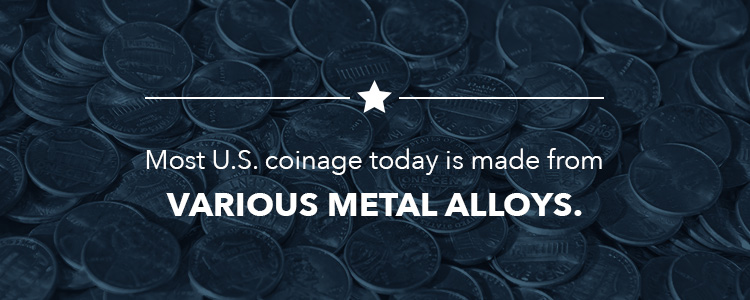
No discussion of the anatomy of coins would be complete without mentioning the materials that make up the coin itself. For anyone who doesn’t know much about the world of coins, it might be easy to assume that all of them are made up of gold or silver, with the exception of something like a copper penny. This, however, is not the case.
Most U.S. coinage today is made from various metal alloys. An alloy is a term for a metal that’s been created by mixing two or more different metals together. In other words, the coins we use in our daily life in the U.S. are never pure gold or pure silver. This varies across special and commemorative coins, but for ordinary quarters, nickels, pennies, and dimes, you’re actually getting a combination of different materials.
An Overview of Current U.S. Coinage
Now that we know a bit about what the different parts of a coin are called and how coins can be decorated, let’s put that knowledge to work for us. We’re going to take a brief look at each of the four major coin denominations in circulation in the U.S. today. While there are other coins, such as the half-dollar and the dollar coin, we’re going to focus on the four denominations that most of us are the most familiar with: the quarter, dime, nickel, and penny.
1. The Quarter
The obverse of a quarter shows an image of George Washington’s profile, making him the primary device. The legend along the top of the coin reads LIBERTY, and there is a smaller motto that reads IN GOD WE TRUST.
Designs featured on the reverse side vary depending on the particular series. For example, we’re all likely familiar with the designs representing the various states and national parks. For the previously standard quarters, however, the design features an eagle clutching a bundle of arrows, surrounded by olive branches. The legends read UNITED STATES OF AMERICA along the top, and QUARTER DOLLAR along the bottom. A smaller motto reads E PLURIBUS UNUM.
In addition to these designs, quarters also have beautiful reeded edges.
2. The Dime
The obverse side of a dime shows the profile of Franklin Roosevelt, as well a legend reading LIBERTY, and a motto reading IN GOD WE TRUST. The date is also present on this side. The reverse shows devices of a lit torch, an olive branch, and an oak branch — symbols of liberty, peace, and strength, respectively. The legends read UNITED STATES OF AMERICA and ONE DIME, with a smaller motto of E PLURIBUS UNUM.
Like the quarter, dimes currently use reeded edges.
3. The Nickel
The obverse of a nickel shows an image of Thomas Jefferson. The corresponding legend and motto are LIBERTY and IN GOD WE TRUST, along with a date inscription. The reverse side shows an image of Jefferson’s home, Monticello. The legends and motto on this side read UNITED STATES OF AMERICA, E PLURIBUS UNUM, and FIVE CENTS, along with a smaller inscription that labels the image as MONTICELLO.
The edge of a nickel is plain.
4. The Penny
Pennies feature an image of Abraham Lincoln on the obverse, along with the legends LIBERTY and IN GOD WE TRUST, and a smaller date mark. The reverse side features the Lincoln Memorial as the device. The legends read UNITED STATES OF AMERICA and ONE CENT. The motto reads E PLURIBUS UNUM.
Like the nickel, the edge of a penny is plain and undecorated.
Browse Coins for Sale Today
Ready to put all this new knowledge to work by shopping for coins to start or add to your own collection? Then now is the perfect time to start by browsing our selection of coins here at American Mint. We offer high-quality specialty coins at reasonable prices, and we offer them all with a guarantee of authenticity so that you can always be sure you’re getting exactly what’s been advertised. And if you’re not satisfied with your purchase, you can always take advantage of our money-back guarantee.
Start shopping coins today to find the next great coin in your collection.
